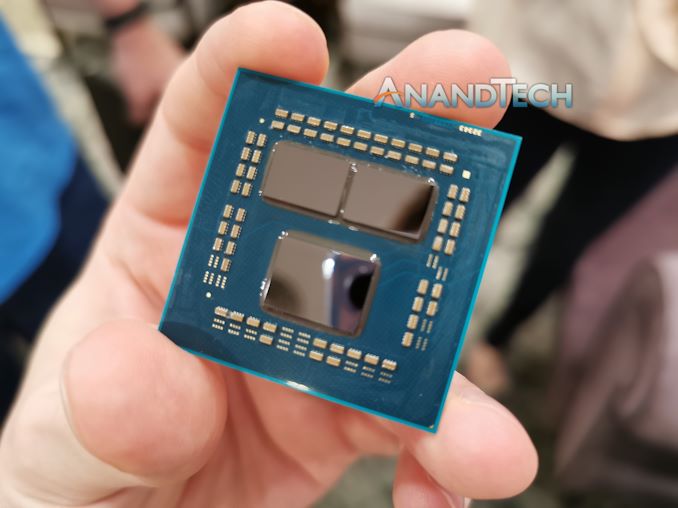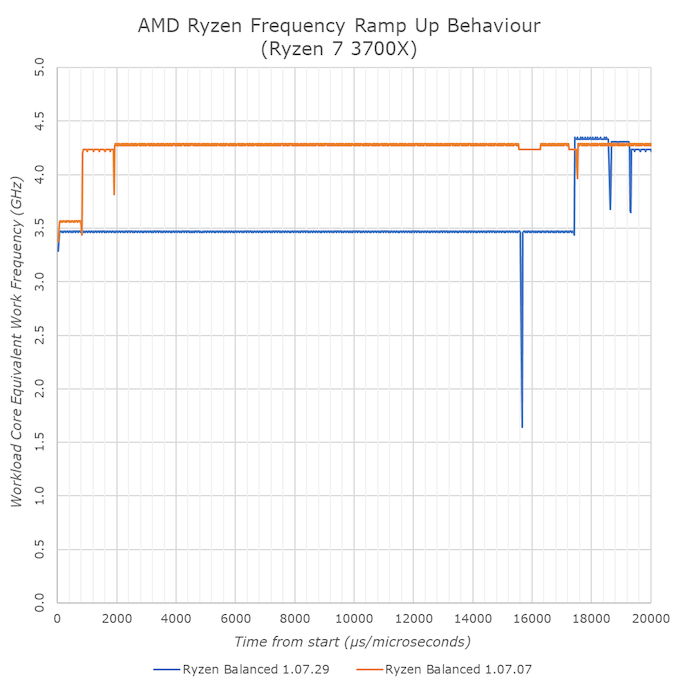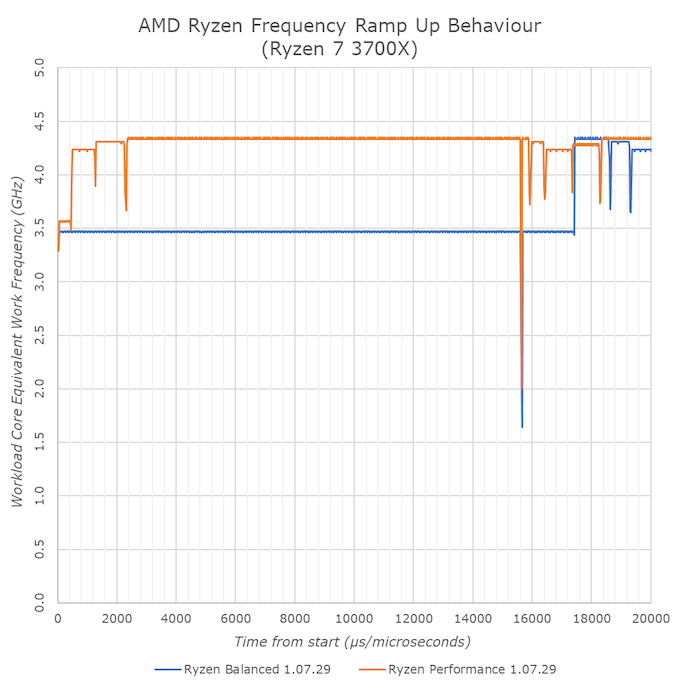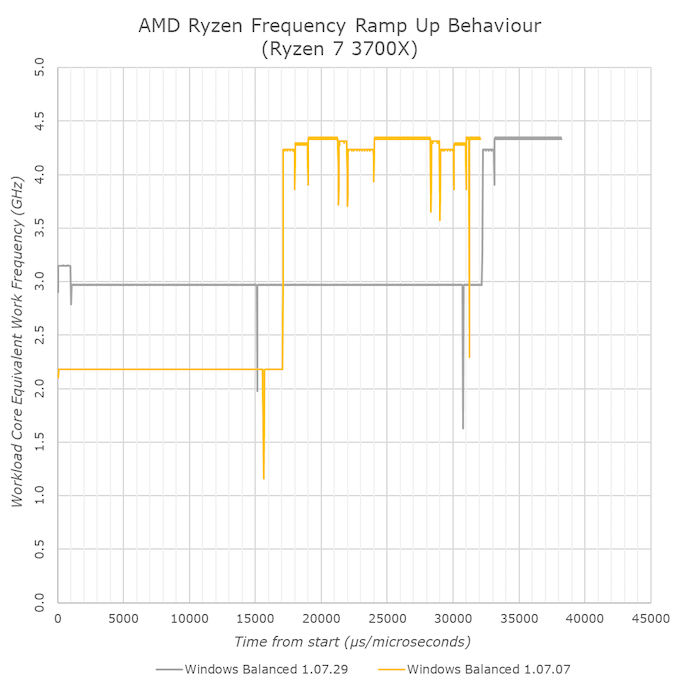AMD Releases New Chipset Drivers For Ryzen 3000: More Relaxed CPPC2 Upscaling
by Andrei Frumusanu on July 30, 2019 5:00 PM EST
It’s been nearly three weeks since AMD’s launch of the new Ryzen 3000 series CPUs and our extensive coverage of the new parts. Among one of the things that didn’t quite go as smoothly is AMD’s BIOS and software situation where as things were still very much in flux following the launch.
One issue that was repeatedly brought up by the community over the past weeks was the new CPU’s idle behaviour both in terms of temperature as well as voltages. In particular, the new parts seemingly looked like they rarely idled at lower performance states and instead looked to remain at high frequencies even when not doing much.
While initially appearing as an issue, it really wasn’t one and rather just a side-effect of AMD’s new CPPC2 fast frequency ramp-up behaviour. Monitoring applications that are badly programmed tend to have a too heavy of a monitoring loop that causes load on the CPU – triggering a frequency ramp-up as the CPU is seeing a larger load. Given the new CPU’s sub-1ms ramp-up this meant that it was very hard to actually catch the machine at the lower frequencies – even though it most likely did idle correctly.
AMD has now addressed this concern and tweaked the CPPC2 behaviour in the new Ryzen power plans with the release of a new chipset driver package.
As AMD states in their community brief on the issue, part of the new behaviour change is that the new scheduler settings will now have a much more relaxed ramp-up time compared to the previous versions. In particular, when the chip will be at its base frequency and idling voltage, it will now take a significantly longer load for the chip to ramp up to its boost frequencies.
In our quick A/B testing between the two driver versions, we can see that prior to the update the CPU would ramp up in around 840 microseconds to its boost clocks, whilst on the new power plan in this data-set took it a longer 17.5 milliseconds.
The new behaviour thus should make the CPU ramp-up much less susceptible to smaller transient loads. The new boost duration is still very much adequate and extremely fast – sustained CPU workloads will see largely imperceptible difference, while intermittent workloads such as games also won’t be affected as once the CPU gets over the initial base frequency ramp threshold it maintains the sub-1ms frequency change behaviour.
Users who with to maintain the fast up-scaling behaviour can choose to use the Performance power plan which largely retains a similar performance profile to that of the previous Balanced profile.
I also took a look at the Windows power plans if they changed, and it seemed that they indeed did. While on the old version the CPU would idle at ~2.2GHz, the new driver idles at 3GHz. Seemingly the frequency up-scaling has also been slightly slowed down as in my quick testing I saw frequency ramp up half as quickly.
AMD has also addressed concerns about the reported high temperatures of the chip. The company explains that generally the value that most applications are reading out is the maximum of several sensors on the chip. Essentially this acts as the junction temperature of the chip – whilst most of the die would actually be a different/lower temperature.
A new version of Ryzen Master now includes a different temperature readout algorithm that is meant to better represent the “overall” temperature of the die rather than the absolute maximum a sensor reports. AMD says this is a better representation of the temperature of the CPU. Besides averaging across different sensors, it also averages readouts over a small time-window. In my testing the most affected scenarios are idle and low-load scenarios and the new temperature behaviour isn’t nearly as erratic and spiky.
Note: People have reported performance degradations with the new driver. These degradations have nothing to do with the new power plan / idle behaviour; it's more likely that this is caused by the temporary workaround for the RDRAND (Destiny 2) issues. One can maintain the original performance with the new Balanced power plan idle behaviour by simply selectively installing the new 5.0.0.0 power plan on top of the 07.07 chipset driver release.
Related Reading:
Source: AMD Community Update














39 Comments
View All Comments
The_Assimilator - Wednesday, July 31, 2019 - link
I don't see how idling at 3GHz is an improvement compared to idling at 2.2GHz, especially when Intel CPUs idle at a mere 800MHz.fatweeb - Wednesday, July 31, 2019 - link
On idle it goes to 0 GHz (CC6 sleep) which no software except Ryzen Master can read without also waking up the CPU.kliend - Wednesday, July 31, 2019 - link
I actually had a performance hit of about 5% in my testing. Using 3900x. I checked, double checked, and triple checked.Asus x570 Pro
Ryzen 3900x (stock cooler @ 100%)
Corsair Vengeance, 3000mhz, C15, 4x8GB
0808 BIOS version
Please see if you see the same? @Anandtech
kliend - Wednesday, July 31, 2019 - link
To be clear, I was getting about 7330 in Cinabench 20.After updating bios from 7011 to 0808, and updating to new drivers,
I now am gettings scores around 6950.
Andrei Frumusanu - Wednesday, July 31, 2019 - link
I can confirm. I address this in the end of the article. You can avoid the perf issue by just installing the new power plan and ignoring the rest of the driver package.kliend - Wednesday, July 31, 2019 - link
Thank you sir!chalupa13 - Thursday, August 1, 2019 - link
it has nothing to do with new chipset drivers. its the new AGESA 3AB microcode that lowers performance. roll back you bios to 7011 or 7004chalupa13 - Thursday, August 1, 2019 - link
I have same MB and CPU. I can confirm that exactly same thing happened to me was getting scores around 7250 and 521 multi/single before bios upgrade. now its around 7000/500. Thanks AMDMugur - Wednesday, July 31, 2019 - link
Why I still see the old horizontal UI in Ryzen Master, instead of the new vertical one? Is it specific to new Ryzen 3000 only? I have a 1600...